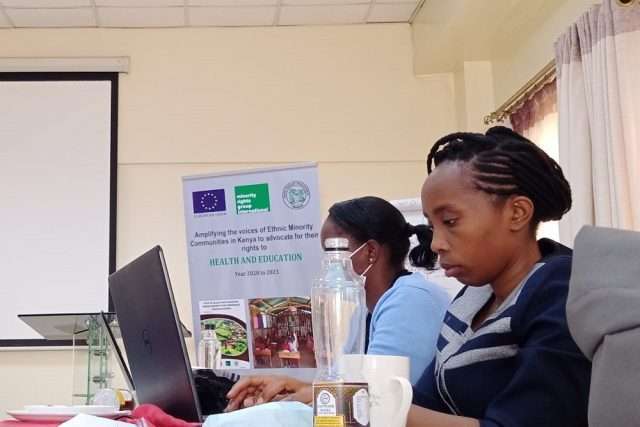Updates on the training of Community health volunteers. Article 12 of the International Covenant on Economic, Social and Cultural Rights provides for the highest attainable standards of physical and mental health. The covenant was adopted by the UN General Assembly on 16th December, 1966 by 171 parties.
At the national level, the Kenyan Constitution 2010 provides that every person has a right to the highest attainable standard of health. Despite the generous provisions, indigenous peoples and ethnic minorities are still struggling to access healthcare services. They walk long distances and their health facilities are ill equipped and in many cases there is inadequate staffing.
A training for Community Health Volunteers (CHVs) was officially commenced yesterday at the Eastmark Hotel.
SUSTAINABLE DEVELOPMENT GOALS (SDGs)
Geoffrey Kerosi presented on Sustainable Development Goal 3 on Good Health and provided a situation analysis among ethnic minorities. There are 17 goals and each goal has targets and indicators to make it easier to assess the progress in achieving these goals.
COMMUNITY HEALTH VOLUNTEERS
The participants also learnt more about the work of community health volunteers.
We learnt about Community Health Strategy and the contents of the Kenya Essential Package of Health (KEPH) which was launched in 2005.
The KEPH has five life cycle services also called cohorts. i) pregnancy and newborns up to 28 days; ii) childhood (29 – 59 months); iii) 5 years – 19 years children and youth; iv) adulthood (20 – 59 years) v) elderly (60+ years).
Further, we learnt about the key actors in the Community Health Unit. These are Community Health Volunteers (CHVs), Community Health Extension Workers (CHEW) and Community Health Committee (CHC).
The Ministry of Health has a well organized community health units with the Form 513 of Ministry of Health which is a household register.
One Community Health Volunteer (CHV) is expected to take care of 500 people and he/she is expected to revise the household register every six months.
Form 514 is a summary logbook which is to be filled every month and handed over to the Community Health Extension Workers.
Roles of Community Health Volunteers (CHVs):
- Guide the community on how to improve health and prevent illness by adopting health practices;
- Treat common illness and minor injuries that occur within the community with support of the CHEW;
- Refer cases to the nearest facility;
- Promote healthcare and seeking and compliance behavior;
- Visit homes to determine the health situation of the community members;
- Promote appropriate home care for the sick;
- Participate in dialogue and action days;
- Being an example and model of good health behavior;
- Motivate members of the community to adopt health practice;
- Maintain household register and community health related events;
Community Health Volunteers are required to have good communication skills. That is both verbal and non-verbal communication such as nodding, eye-contact, facial expression, leaning forward or back-backwards.
Community health volunteers have various channels of communication such as radio, newspapers, television, drama, road shows as well as one-on-one counselling sessions.
Clear messages are important and their design must consider cultural sensitivity and then pass them using appropriate channel. When communicating make sure you have clear goals and specific objective.
There are barriers to effective communication such as language, age, status, political differences, mistrust, timing, culture and level of education.
We learned that Community Health Volunteers should know the available opportunities in order to refer people to benefit from the same. Some of the opportunities which we looked at are: Old persons Cash Transfer (OPCT), Cash Transfer for Orphans and Vulnerable Children (CT-OVC) and Severe disability cash transfer.
How can Tuberculosis be controlled?
In order to control Tuberculosis or TB as it is commonly referred, patients should avoid use of public transport, stay at home from work, school or other public places.
The CHVs are required to raise awareness on sexually transmitted through sexual contact such as Human Papillomavirus (HPV), Genital harpes, chlamydia (has no symptoms), gonorrhea (if untreated may cause infertility), syphilis starts as a painless sore and finally Hepatitis A,B and C which affects the liver.
SYPHILIS
Syphilis is marked by red or reddish brown penny-sized sores over any area of your body. It leads to enlarged lymph nodes, head, bevaviour changes and movement problems.
GONORRHEA
The symptoms of this disease is thick cloudy or bloody discharge from the penis or vagina. Patients also experience pain or burning sensation when urinating and for women, they experience heavy menstrual bleeding in between periods.
COVID-19
Coronavirus disease has been with us in Kenya since March 2020. There has been a number of variants of the virus such as Delta and the most recent is Omicron.
The symptoms of Covid-19 are lose of taste and smell, fever, headache, cough, tiredness, sore throat, diarrhea, discoloration of fingers and toes.
CANCER
The causes of cancer is not known and it can attack any part of the body such as the skin, blood, throat, lungs and breasts etc.
One can get cancer through cigarette smoking, over-consumption of alcohol, exposure to certain chemicals, genetics, age. When you drink too much alcohol you are likely to developed liver cancer. Industrial dyes and skin lightening chemicals are most likely to cause cancer.
Exposure to repeated radiation can cause cancer. Human Pavilion Virus (HPV) affects girls who start engaging in sex early are at a higher risk of getting infected with cancer. This is why girls who attain the age of 10 years are vaccinated to protect them from cervical cancer.
Genital Human Papilloma Virus (HPV) affect areas around the vagina, penis and anus. The HPV affect the skin.
Women are advised to not ignore any lump that they find on their breasts. This might be an early symptom of cancer.
Men are encourage to touch and press the breasts of their wives and ensure there are no lumps in them. When the lump is discovered in the breasts, it can be removed and one becomes a cancer survivor.
In the past, early stages of cancer have been discovered by their husbands or lovers.
We should avoid exposure to radiation, stop smoking and excessive drinking of alcohol. Women should avoid hormonal contraceptives if their mothers had breast cancer. Those who are brown skinned should apply sunscreen to protect their skin from exposure from cancer.
People are advised to avoid being overweight by avoiding high fat diet and instead consume high fiber diet. For example make it an habit to drink porridge.
People can also use vaccination against Hepatitis B to avoid getting liver cancer. When discovered early cancer can be removed through surgery. If the cancer has affected the entire area, the breast can be removed.
Chemotherapy is used when cancer has spread to the entire body. These are some of the ways of treatment. Cancer patients have low immunity and as a result they should be encouraged to eat a balanced diet and be given hope because cancer is a terminal disease.
You might be aware that nursing patients with terminal diseases is not easy.
https://twitter.com/gkerosi/status/1468513211683164170
https://twitter.com/gkerosi/status/1468515197556035588
GOT a story? Contact Kerosi Dotcom on EMAIL info@kerosi.com


